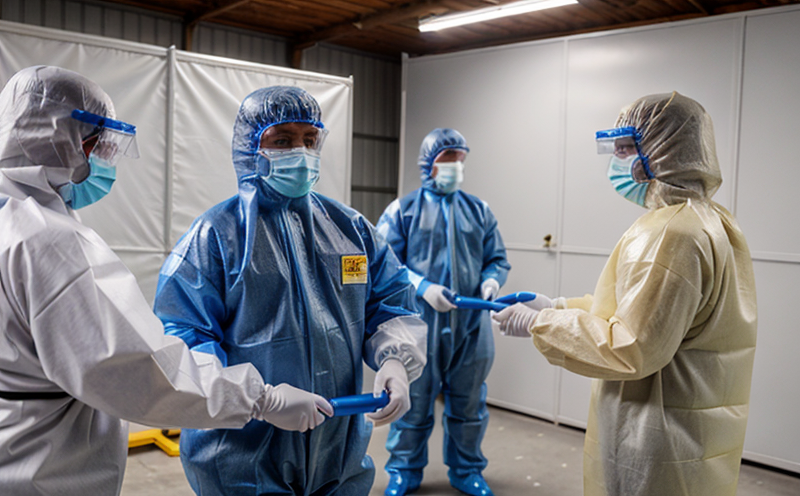ISO 11611 Welding workwear Performance requirements and testing
The ISO 11611 standard is a set of performance requirements and test methods for welding protective clothing. This standard aims to ensure that the protective clothing used by welders not only withstands the hazards of welding but also provides adequate protection against thermal, mechanical, and other potential risks. The standard covers various aspects such as flame resistance, heat resistance, mechanical properties, and permeability tests.
Flame resistance testing ensures that the fabric does not ignite or smolder when exposed to a flame for a specified duration. Heat resistance tests assess how well the material resists high temperatures without melting or deforming. Mechanical performance includes tensile strength, tear resistance, puncture resistance, and seam slippage tests.
The permeability test evaluates whether harmful substances can pass through the fabric under certain conditions. This is crucial for ensuring that workers are not exposed to hazardous materials while performing their duties. The standard also provides guidelines on how to prepare specimens for testing, calibrate equipment, and interpret results accurately.
For quality managers and compliance officers responsible for ensuring worker safety in industrial settings, understanding these requirements is essential. Compliance with ISO 11611 helps organizations meet regulatory standards and demonstrates a commitment to employee well-being. R&D engineers can use this knowledge to innovate safer products while adhering to international norms.
When selecting protective clothing for welding tasks, it's important to consider not only the material composition but also how well it meets the specified performance criteria outlined in ISO 11611. Proper selection ensures that workers are adequately protected against potential hazards associated with welding operations.
The testing process typically involves several steps including sample preparation, conditioning, and conducting individual tests according to prescribed methods. Specimens must be prepared following specific guidelines to ensure accurate results. Calibration of equipment used during the tests is critical to maintain precision throughout the procedure.
After completing all necessary tests, detailed reports are generated summarizing findings. These documents serve as evidence that the protective clothing meets the stringent requirements set forth by ISO 11611. Accurate documentation supports ongoing efforts towards maintaining high standards of occupational health and safety practices within workplaces.
Industry Applications
| Application Area | Description |
|---|---|
| Welding Operations | Protective clothing designed to meet ISO 11611 standards is essential for welders who work in environments where there's a risk of burns from sparks and flames. |
| Hazardous Environments | In addition to welding, this standard can be applied in other industries such as manufacturing or construction where employees may encounter similar hazards. |
| Firefighting | Although primarily focused on industrial workers, the principles behind ISO 11611 could also apply to certain firefighting scenarios involving protective clothing. |
Why Choose This Test
Selecting protective clothing that adheres to the rigorous standards set by ISO 11611 offers numerous advantages for employers and workers alike. Firstly, it ensures maximum protection against thermal injuries commonly encountered during welding processes.
Secondly, compliance with this standard enhances overall safety protocols within your organization, reflecting positively on both internal and external stakeholders. By investing in high-quality protective equipment, you demonstrate a proactive approach to safeguarding employee welfare.
Thirdly, adhering to internationally recognized standards like ISO 11611 can help streamline regulatory compliance processes across different countries or regions where your business operates. This uniformity simplifies procurement procedures and reduces administrative burdens associated with varying local regulations.
Lastly, choosing products tested according to these stringent criteria fosters trust among employees who know they are being provided with reliable gear capable of performing under demanding conditions. This can significantly boost morale and productivity levels within teams tasked with executing hazardous tasks like welding.
International Acceptance and Recognition
The ISO 11611 standard has gained widespread acceptance across various industries worldwide due to its comprehensive approach towards evaluating the performance characteristics of protective clothing used in welding environments. Many countries have adopted this standard as part of their national regulations or guidelines for workplace safety.
For instance, European Union directives often reference ISO standards like 11611 when specifying requirements for personal protective equipment (PPE). Similarly, American National Standards Institute (ANSI) Z89.2 also aligns closely with many aspects covered by ISO 11611 but may have slight differences in certain areas.
By ensuring that your organization meets these internationally recognized standards, you open up opportunities for global collaboration and expansion into markets where similar requirements exist. Moreover, it allows employees to feel secure knowing their protective clothing meets the highest international safety benchmarks available today.





